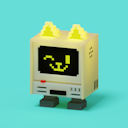Introducing KittyCAD
In the software world, we have paradigms for building, testing, and deploying applications automatically. We’ve gotten very good at reducing the load on developers so that with a simple push of a commit to a git repo a Rube Goldberg machine is triggered resulting in an artifact. The artifact could be many different things: test output, linting, a deployment, and more. Programmability extends far beyond a push of a repo, it is embedded in text editors through plugins. For software developers, everything is programmable, scriptable, and capable of being automated in any language of your choice.
In the hardware world, specifically that of mechanical CAD, these paradigms do not yet exist. Any faint resemblance of software automation is limited to specific languages, incomplete interfaces, and single-threaded runtime environments. The world of mechanical CAD has not been innovated in quite some time.
A few months ago, we opened a public readme on a GitHub repo to try to find people who thought similarly to us. We were looking for people who understood both the software and hardware worlds and saw these large puzzle pieces missing to bring mechanical CAD to the future, to make mechanical CAD programmable with similar paradigms to that of software in terms of plugins, testing, and collaboration.
For example, imagine you push a change to a CAD model and you trigger your own Rube Goldberg machine that runs all the simulations for air flow and thermals and outputs whether your change is okay to be merged. Or, a custom plugin for your CAD program that automatically does the right topology transformations to your model for your product on save. As you can imagine these are small examples of a much larger vision of what would be possible. With an open ecosystem, much like that of developer tools, all these scripts, automations, and plugins would be available for people to share and modify for their own use cases.
Our call to action to find folks who saw this same future had a great response! The energy from talking to people who see all the same problems and want the same future is utterly contagious. Because of the response, we knew what we had to do to: start a company. By starting a company, we can ensure that this vision becomes a reality and is sustainable over time.
Seeing as Embedded Ventures’ purpose is to fund hard tech founders, naturally a tool to help people building hard tech would also have a very happy home there as an incubated company. The Embedded team is made up of founders and advisors who have viscerally felt the pain of the existing tools so it is a perfect fit.
Today, we are ecstatic to announce KittyCAD! KittyCAD's purpose is to build the mechanical CAD of the future: fully programmable, user friendly, multi-threaded, and fast. To learn more about the current state of the industry and where we want to head, please read Mechanical CAD: Yesterday, Today, and Tomorrow.
We are looking for two operational founders to join our mission and help build this company with us. The three of us know how important it is that this company exists, and will work tirelessly to make sure it is successful, however we are each responsible for other companies as well. This is a very exciting opportunity to pave the path for the future of hardware engineering. We are at the epicenter of a new wave of hardware developer tooling and KittyCAD will help enable more people to build hardware than ever before.
Whether you are building hardware or software you want to build, you want to run with your idea until you reach your ultimate vision. Your tools should enable you to get there faster. They should unblock you from wasting time on repetitive tasks and let the computers work for you.
To all the builders, present and future, with a vision of what they want to build, the future is just getting started and we hope KittyCAD will help make your dream a reality!
